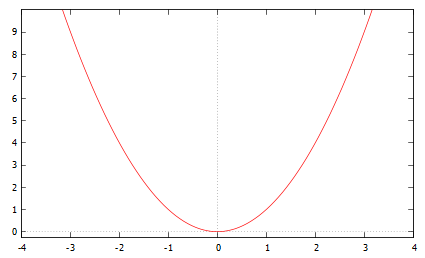Parametric Functions
Definition
A parametric equation is one where the $x$ and $y$ coordinates of the curve are both written as functions of another variable called a parameter; this is usually given the letter $t$ or $\theta$.
For example, \[x = t^2,\; y=2t, \qquad x = \sin^2\theta, \; y=\cos^2\theta\]
$\theta$ tends to be used when working with trigonometric funtions.
Plotting Graphs
Definition
The easiest way to plot a curve from parametric equations is to make a table and plot the points. Alternatively, it can be transformed into a single cartesian equation first and then plotted.
Worked Example
Plot the curve given by $x=t$ and $y=t^2$.
Solution
Make a table and for every value of $t$, work out the corresponding $x$ and $y$ values.
|
t |
-3 |
-2 |
-1 |
0 |
1 |
2 |
3 |
|---|---|---|---|---|---|---|---|
|
x |
-3 |
-2 |
-1 |
0 |
1 |
2 |
3 |
|
y |
9 |
4 |
1 |
0 |
1 |
4 |
9 |
Now we have a table of $x$ and $y$ coordinates which can be easily plotted on a graph.

Cartesian Equation
Definition
A cartesian equation is only in terms of $x$ and $y$, so we must eliminate the parameter. To do this either, rearrange one of the parametric functions to get $t=\dotso$ and then substitute this into the other equation, or use a trigonometric identity to eliminate the $\theta$.
Worked Examples
Worked Example
Express the parametric equations $x=t^2$ and $y=2t$ in Cartesian form.
Solution
Rearrange the first equation to make $t$ the subject
\[t = \sqrt{x}.\]
Sub this into the second equation to eliminate the parameter $t$
\[y = 2\sqrt{x}.\]
So the Cartesian form of these parametric equations is
\[y = 2\sqrt{x}.\]
Worked Example
Express the parametric equations $x = 3\sin\theta$ and $y=4\cos\theta$ in Cartesian form.
Solution
Using the identity $\cos^2\theta+\sin^2\theta=1$.
Find $\sin^2\theta$.
\begin{align} x &= 3\sin\theta\\\\ \frac{x}{3} &= \sin\theta\\\\ \sin^2\theta &= \frac{x^2}{9} \end{align}
And $\cos^2\theta$.
\begin{align} y &= 4\cos\theta\\\\ \frac{y}{4} &= \cos\theta\\\\ \cos^2\theta &= \frac{y^2}{16} \end{align}
Subbing these into the identity will eliminate $\theta$ and give the Cartesian form.
\[\frac{y^2}{16} + \frac{x^2}{9} = 1\]
Finding the Gradient
Definition
To find the gradient, we use the Chain Rule. We differentiate both our equations and use the rule: \[\frac{\mathrm{d}y}{\mathrm{d}x} = \frac{\mathrm{d}y}{\mathrm{d}t} \frac{\mathrm{d}t}{\mathrm{d}x}\] Alternatively, the parametric equations can be transformed into cartesian equations first and then differentiated as normal.
Worked Example
Find the gradient of the curve given by the parametric equations $x=t^2$ and $y=2t$.
Solution
Using $\dfrac{\mathrm{d}y}{\mathrm{d}x} = \dfrac{\mathrm{d}y}{\mathrm{d}t} \dfrac{\mathrm{d}t}{\mathrm{d}x}$.
First find $\dfrac{\mathrm{d}y}{\mathrm{d}t}$.
\[y = 2t \; \Rightarrow \dfrac{\mathrm{d}y}{\mathrm{d}t} = 2\]
Then find $\dfrac{\mathrm{d}x}{\mathrm{d}t}$.
\[x = t^2 \; \Rightarrow \dfrac{\mathrm{d}x}{\mathrm{d}t} = 2t\]
Finally, substitute these into the chain rule formula given above. Don't forget to flip $\dfrac{\mathrm{d}x}{\mathrm{d}t}$ as we need $\dfrac{\mathrm{d}t}{\mathrm{d}x}$ in the formula.
\[\frac{\mathrm{d}y}{\mathrm{d}x} = 2 \times \frac{1}{2t}\]
\[\frac{\mathrm{d}y}{\mathrm{d}x} = \frac{2}{2t}\]
\[\frac{\mathrm{d}y}{\mathrm{d}x} = \frac{1}{t}\]
Workbook
This is a workbook on graphs of functions and parametric form produced by HELM.
This is a workbook on parametric curves produced by HELM.
See Also
External Resources
- Parametric differentiation workbook at mathcentre.